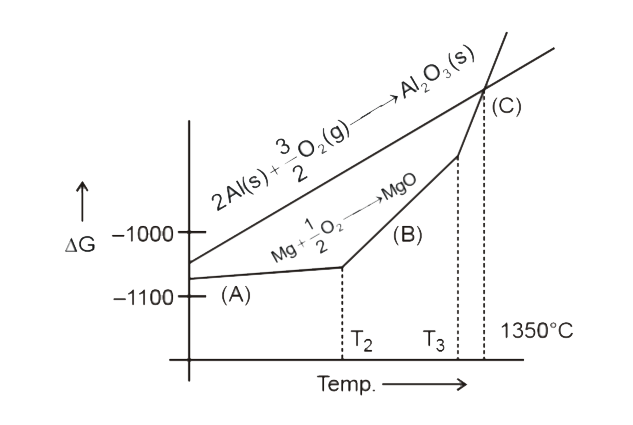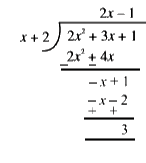Which of the following statements are true :
A→Mg(s)+12O2(g)T1−−→MgO(s)
B→mg(?)+12O2(g)T2−−→MgO(s)
C→mg(g)+12O(g)T3−−→MgO(s)

I : Below 1350∘ Mg can reduce Al2O3
II : Above 1350∘C Mg Will reduce Al2O3
III : Below 1350∘ Al can reduce MgO
IV : Above 1350∘ Al can reduce MgO
V : At 1350∘C there is no change in free energy i.e., ΔG=0
Text Solution
3MgO+2AlItsΔF high then above 1350∘C−−−−−−−−−−−→Al2O3+3Mg,ΔG<0ItsΔGless
Al2O3+3MgBelow1350∘C−−−−−−−→3MgO+2Al
At 1350∘C both reactions have same G
∴ΔG=0
To carry out smelting below 800∘C , CO is used as reducing agent while above 800∘C , smelting is carried out by coke.
2C(s)+O2(g)→2CO(g)ΔH=- 221.0 kJ/,mole ΔS=+179.4 JkJ/molC(s)+O2(g)→CO2(g)ΔH=-395.5kJ/mol ΔS=2.89JK−1mole−1

• Aluminium can be extracted from Alumina by carbon reduction but the method is highly uneconomical because -
(i) As the smelting occurs above 200∘C hence a part of the aluminium will go into vapour phase (M.P.=2520∘C)
(ii) At this high temperature the liberated Al will combine with the carbon & aluminium carbide will be formed.
(iii) ΔHfor for of alumina is high – ve value
∴ It is thermodynamically more stable & reduction is more difficult
• To extract metal from sulphide ore is carried out by firstly roasting it into metal oxide & followed by its smelting. Metal sulphide or sulphide ore is not directly smelted to metal.
2PbS+CΔ−−→2Pb+CS2 (Thermodynamically Not feasible )
PbS+32O2Δ−−→PbO+SO2↑⏐
⏐⏐
PbO+CΔ−−→Pb+CO↑⏐⏐} Thermodynamically feasible
ΔGf of PbS = –21.9 kcal/mol
ΔGf of CS2 = +17.15 kcal/mol
ΔGf of PbO = –45.1 kcal/mol
ΔFf of SO2 = - 71.7 kcal/mol
ΔGf of = – 32.8 kcal/mol
|
Topper's Solved these Questions
- METALLURGYBOOK - MOTIONCHAPTER - METALLURGYEXERCISE - EXERCISE 1
50 Videos
- METALLURGYBOOK - MOTIONCHAPTER - METALLURGYEXERCISE - EXERCISE 2 (LEVEL - I)
70 Videos
- LIQUID SOLUTIONBOOK - MOTIONCHAPTER - LIQUID SOLUTIONEXERCISE - EXERCISE-4 (Level-II) PREVIOUS YEAR JEE ADVANCED
19 Videos
- MOLE CONCEPTBOOK - MOTIONCHAPTER - MOLE CONCEPTEXERCISE - EXERCISE - 4 LEVEL - II
13 Videos
Similar Questions
Knowledge Check
3Mg(s)+N2(g)Δ−−→Mg3N2(s) is -
ADecomposition reactionBCombination reactionCDisplacement reactionDNone of theseWhich of the given statements is (are) correct about the following reaction ?
MgO(s)+H2O(l)→Mg(OH)2(s)+ heatAcombination and endothermicBDisplacement and exothermicCCombination and exothermicDNone of the aboveThe equation 2Al(s)+32O2(g)→Al2O3(s) shows that .
A2 moles of Al react with 32 moles of O2 to produce 72 moles of Al2O3B2 g of Al react with 32 g of O2 to produce one mole of Al2O3C2 g of Al react with 32 litre of O2 to produce 1 mole of Al2O3D2 mole of Al react with 32 moles of O2 to produce 1 mole of Al2O3
What is the coefficient of MgO in the following reaction? 2Mg+O2→2MgO
View SolutionComplete the following :
(i) CaSO4.2H2Oheat−−→ (ii) MgO+C+CI2heat−−→
(iii) Mg(NO3)2Heat−−→ (iv) Mg+NOHeat−−→
CaC2+N2→ (vi) Mg3N2+H2O→
View SolutionIt is true that under certain condition, Mg can reduce Al2O3 and Al can reduce MgO? What are those conditions?
View SolutionIt is true that under certain condition, Mg can reduce Al2O3 and Al can reduce MgO? What are those conditions?
View SolutionIdentify from the following reactions the reactants that undergo oxidation and reduction.
2Mg+O2Δ−−→2MgO
View Solution
